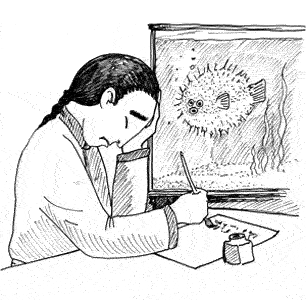STRANGE BUT TRUE- Fugu you: A fishy way to kill yourself

Q. "I cannot see her tonight./ I have to give her up/ So I will eat fugu." Any idea what the Japanese poet has in mind here? Let the eater beware! –H. O. Hito
A. Intensive training is necessary to become licensed as a fugu chef in Japan, but it's worth the effort, says Nigel Calder in Magic Universe. Gourmets pay astounding prices for the right to court death by eating the most esteemed and dangerous fugu, alias the pufferfish or blowfish.
Consuming just a smidgeon of its liver may render a person unable to breathe within minutes due to the poison tetrodotoxin (TTX).
"It's a recognized though nasty way of committing suicide," seemingly the poet's intention. The stuff is 10-100 times as lethal as black widow spider venom, 10,000 times cyanide, says Jim Johnson on Bristol University's "Molecule of the Month." A single mg or less– on the head of a pin– can kill an adult. Numbing of the lips and tongue may progress to paralysis, the victim unable to move though fully conscious and even lucid before death within 4-6 hours (associated with Haitian zombie-ism).
Recently the world's biologists have studied the fugu genome, 1/8th the size of the human genome yet with a similar set of genes and therefore promising and revealing, says Calder.
"Some 450 million years have elapsed since we and the fugu last shared a common ancestor, yet more than 75 percent of the fish's genes crop up in the human genome."
Q. If "One dog year = seven human years," how much does one cat year equal? –J. Fariello
A. The premise is wrong, says Philip Kass of the University of California-Davis. Different dog breeds have different lifespans: Great Danes usually live less than 10 years, but small breeds go into their late teens.
Generally in the mammalian kingdom, bigger animals live longer because small animals lose their heat faster and so need faster heart rates (metabolism), thus wearing out their "ticker" faster, says James H. Jones, also of the University of California-Davis. But big dogs are not the true "canid" form, having been artificially selected and bred by humans in such a way that bigger dogs wind up with shorter lifespans. As a result, cats tend to live longer than dogs.
But with cats, there are really two different lifespans– outdoors v. indoor, says Niels Pedersen, professor of veterinary medicine at the school. The average lifespan for an outdoor cat is around 4-5 years, for a well-cared-for indoor cat, 15-20+ years. So for the first, the ratio is one cat year = 18 human years, for the second, five human years, based on an 80-year average for people.
Q. Art lovers, next time you're at a museum looking at a favorite painting, try shutting one eye and backing off a distance. Do you see the improvement?– L. Parsons
A. No less a genius than Leonardo da Vinci recommended this, and several hundred years ago it became fashionable to hang a dark curtain with a small viewing hole in front of paintings, says Margaret Livingstone in Vision and Art: The Biology of Seeing. The point was to allow viewers to appreciate the illusion of depth in the two-dimensional painting. Normally our two eyes have slightly different perspectives on real 3-D objects, and so see slightly different images (stereopsis).
But this is not true when we look at a painting, plus there is no relative movement of the different objects portrayed, so our brain knows the scene is in fact flat.
To help preserve the illusion of 3-D, advised da Vinci, you should view paintings with only one eye and at a long distance. Try it," says Livingstone. "It works."
Q. Ever feel like tearing your hair out? If you've literally done this, you're not alone. What's TTM? –R. Punzel
A. Short for trichotillomania, it's hair-pulling compulsion involving the scalp, eyebrows and eyelashes, and afflicting as many as 1 in 50 people, mostly women. Some rip out hair and eat the roots, says Clifford A. Pickover in Strange Brains and Genius. Often this is done in highly orderly fashion, i.e., four hairs from the right side of the head, then four from the left.
The cause is unknown and treatment difficult– especially since "sufferers" seem to take such pleasure in doing it– but forms of aversion therapy help, along with Prozac and other drugs. Still, relapses are the rule.
Dr. Judith Rapoport has theorized it's a basic grooming ritual gone wild, as the behavior's been observed in cats, dogs, monkeys, horses, sheep, birds– and rats, including "barber rats" that are such super groomers they clip off cagemates' hair and whiskers, but only in the dark.
Send Strange questions to brothers Bill and Rich at , coauthors of "Can a Guy Get Pregnant? Scientific Answers to Everyday (and Not-So- Everyday) Questions," from Pi Press).
#